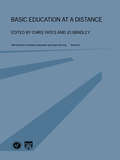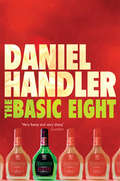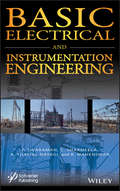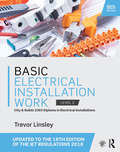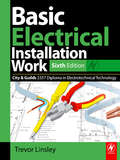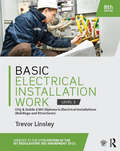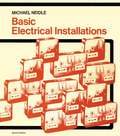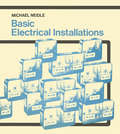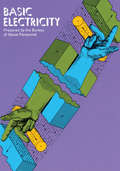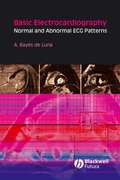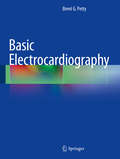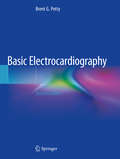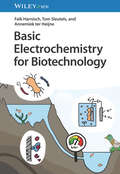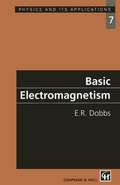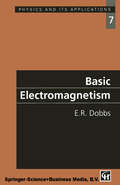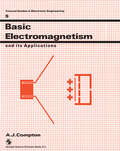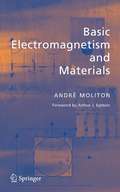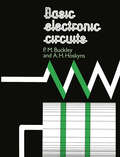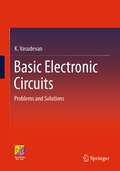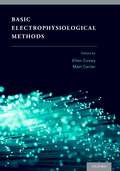- Table View
- List View
Basic Education at a Distance: World Review of Distance Education and Open Learning: Volume 2 (World Review Of Distance Education And Open Learning Ser. #Vol. 2)
by Chris Yates Jo BradleyOpen and distance learning has been used in many ways in the recent past to provide both primary education and adult education. The Commonwealth of Learning works with governments, schools and universities with the aim of strengthening the capacities of Commonwealth member countries in developing human resources required for their economic and social development. Many existing policy documents link distance education with new information and communication technologies, portraying them as a promising universal access and exponential growth of learning.This book answers the key questions to these issues and assesses the impact and effect of the experience of basic education at a distance all over the world and in a wide variety of forms. This is the first major overview of this topic for twenty years.
The Basic Eight
by Daniel Handler'This is not some true-crime tell-all. This is my actual journal, with everything I wrote at the time, edited by me. The revisions are minor; I only changed things when I felt that I wasn't really thinking something that I wrote at the time, and probably would have thought something else. After all, I was only eighteen then.'Meet Flannery Culp, a world-weary high school senior. She is primed to taken on the few remaining obstacles that stand between her and the rest of her life: the SAT, college applications, the autumn term... Mercifully, there are a couple of distractions:1) her friends: Kate (the Queen Bee), Natasha (less like a high school student and more like an actress playing a high school student on TV), Gabriel (the kindest boy in the world and in love with Flan), Lily, Douglas, V– (her name has been deleted to protect her prominent family), and Jennifer Rose - the Basic Eight.2) Adam State, a well-groomed, polite young man and the object of Flan's affections.If only things hadn't gotten out of control. If only Flan had stayed away from the absinthe. Then she wouldn't be a topic on daytime talk shows, or on the cover of tabloids, or incarcerated, or have time to edit her journals... The supremely talented Daniel Handler has perfectly captured the absurdity of school life in this wickedly funny, dark-as-can-be novel.
Basic Electrical and Instrumentation Engineering
by P. Sivaraman C. Sharmeela A. Thaiyal Nayagi R. MahendranElectrical and instrumentation engineering is changing rapidly, and it is important for the veteran engineer in the field not only to have a valuable and reliable reference work which he or she can consult for basic concepts, but also to be up to date on any changes to basic equipment or processes that might have occurred in the field. Covering all of the basic concepts, from three-phase power supply and its various types of connection and conversion, to power equation and discussions of the protection of power system, to transformers, voltage regulation, and many other concepts, this volume is the one-stop, "go to" for all of the engineer's questions on basic electrical and instrumentation engineering. There are chapters covering the construction and working principle of the DC machine, all varieties of motors, fundamental concepts and operating principles of measuring, and instrumentation, both from a "high end" point of view and the point of view of developing countries, emphasizing low-cost methods. A valuable reference for engineers, scientists, chemists, and students, this volume is applicable to many different fields, across many different industries, at all levels. It is a must-have for any library.
Basic Electrical and Instrumentation Engineering
by P. Sivaraman C. Sharmeela A. Thaiyal Nayagi R. MahendranElectrical and instrumentation engineering is changing rapidly, and it is important for the veteran engineer in the field not only to have a valuable and reliable reference work which he or she can consult for basic concepts, but also to be up to date on any changes to basic equipment or processes that might have occurred in the field. Covering all of the basic concepts, from three-phase power supply and its various types of connection and conversion, to power equation and discussions of the protection of power system, to transformers, voltage regulation, and many other concepts, this volume is the one-stop, "go to" for all of the engineer's questions on basic electrical and instrumentation engineering. There are chapters covering the construction and working principle of the DC machine, all varieties of motors, fundamental concepts and operating principles of measuring, and instrumentation, both from a "high end" point of view and the point of view of developing countries, emphasizing low-cost methods. A valuable reference for engineers, scientists, chemists, and students, this volume is applicable to many different fields, across many different industries, at all levels. It is a must-have for any library.
Basic Electrical Installation Work
by Trevor LinsleyEverything needed to pass the first part of the City & Guilds 2365 Diploma in Electrical Installations. Basic Electrical Installation Work will be of value to students taking the first year course of an electrical installation apprenticeship, as well as lecturers teaching it. The book provides answers to all of the 2365 syllabus learning outcomes, and one chapter is dedicated to each of the five units in the City & Guilds course. This edition is brought up to date and in line with the 18th Edition of the IET Regulations: It can be used to support independent learning or a college based course of study Full-colour diagrams and photographs explain difficult concepts and clear definitions of technical terms make the book a quick and easy reference Extensive online material on the companion website www.routledge.com/cw/linsley helps both students and lecturers
Basic Electrical Installation Work: City And Guilds Edition
by Trevor LinsleyEverything needed to pass the first part of the City & Guilds 2365 Diploma in Electrical Installations. Basic Electrical Installation Work will be of value to students taking the first year course of an electrical installation apprenticeship, as well as lecturers teaching it. The book provides answers to all of the 2365 syllabus learning outcomes, and one chapter is dedicated to each of the five units in the City & Guilds course. This edition is brought up to date and in line with the 18th Edition of the IET Regulations: It can be used to support independent learning or a college based course of study Full-colour diagrams and photographs explain difficult concepts and clear definitions of technical terms make the book a quick and easy reference Extensive online material on the companion website www.routledge.com/cw/linsley helps both students and lecturers
Basic Electrical Installation Work 2357 Edition, 6th ed
by Trevor LinsleyThis textbook covers all the material you need to pass the first part of the new City & Guilds 2357 Diploma in Electrotechnical Technology Aligned with the 17th edition IEE Wiring Regulations, this new edition has been thoroughly updated to cover the ‘knowledge’ section of the latest 2357 course. Written in an accessible style and with a separate chapter for each unit, this book helps you to master each topic before moving on to the next. End of chapter revision questions help you to check your understanding and consolidate the key concepts learned in each chapter. With associated online animations and instructional videos to further support your learning, this is the text that no electrical installations student should be without. Also available: Advanced Electrical Installation Work 6th editionTrevor LinsleyISBN: 9780080970424
Basic Electrical Installation Work 2357 Edition, 6th ed
by Trevor LinsleyThis textbook covers all the material you need to pass the first part of the new City & Guilds 2357 Diploma in Electrotechnical Technology Aligned with the 17th edition IEE Wiring Regulations, this new edition has been thoroughly updated to cover the ‘knowledge’ section of the latest 2357 course. Written in an accessible style and with a separate chapter for each unit, this book helps you to master each topic before moving on to the next. End of chapter revision questions help you to check your understanding and consolidate the key concepts learned in each chapter. With associated online animations and instructional videos to further support your learning, this is the text that no electrical installations student should be without. Also available: Advanced Electrical Installation Work 6th editionTrevor LinsleyISBN: 9780080970424
Basic Electrical Installation Work 2365 Edition
by Trevor LinsleyEverything needed to pass the first part of the City & Guilds 2365 Diploma in Electrical Installations Updated in line with the 3rd Amendment of the 17th Edition IET Wiring Regulations, this new edition covers the City & Guilds 2365-02 course. Written in an accessible style with a chapter dedicated to each unit of the syllabus, this book helps you to master each topic before moving on to the next. End of chapter revision questions enable learners to check their understanding and consolidate key concepts learnt in each chapter. With a companion website containing videos, animations, worksheets and lesson plans this resource will be invaluable to both students and lecturers alike. The eighth edition contains: Full-colour diagrams and photographs to explain difficult concepts Clear definitions of technical terms to make the book a quick and easy reference Extensive online material to help both students and lecturers The companion website material is available at www.routledge.com/cw/linsley
Basic Electricity (Dover Books on Electrical Engineering)
by U.S. Bureau PersonnelThis expanded and revised U.S. Navy training course text provides thorough coverage of the basic theory of electricity and its applications. It is unquestionably the best book of its kind for either broad or more limited studies of electrical fundamentals.It is divided into 21 chapters and an extensive section of appendixes. Chapters cover safety, fundamental concepts of electricity, batteries, series direct-current circuits, network analysis of direct-current circuits, electrical conductors and wiring techniques, electromagnetism and magnetic circuits, introduction to alternating-current electricity, inductance, capacitance, inductive and capacitive reactance, fundamental alternating-current circuit theory, direct-current generators, direct current motor magnetic amplifiers, and synchros and servomechanisms. Appendixes acquaint lay readers with common terms, abbreviations, component color-code, full load currents of motors, and cable types; they also supply trig functions, square and square roots, basic formulas, and laws of exponents.Thus the reader is supplied with a complete basic coverage of all important aspects of electricity. And, drawing on its ample funds, the Navy was able to fill this text with dozens of illustrations so that the book becomes almost a multimedia teaching process.This is an excellent text for classroom use or for home study. Students will also find it a valuable supplement to courses in which theory is emphasized while little attention is paid to application; it will also supplement a course in which this situation is reversed. In addition, Basic Electricity serves the lay reader who simply wants a knowledge of fundamental concepts of electricity or wishes to study more advanced concepts and applications. 1969 edition.
Basic Electrocardiography: Normal and Abnormal ECG Patterns
by Antoni Bayés de LunaElectrocardiography is a simple investigation to perform, but accurate interpretation can be challenging. This book takes a logical and systematic approach to ECG interpretation, beginning with the basics of normal variations and dealing in turn with atrial abnormalities, ventricular enlargement, ventricular conduction defects and ischemic heart disease. Extensively illustrated with ECG tracings that complement the text, this book provides clear and concise explanations of traditional concepts of electrocardiography and combines them with updates on the most recent developments in the field. In 22 clinical cases, Professor Bayés de Luna illustrates the principles of the book by integrating electrocardiographic features with clinical findings for a thorough and methodical approach to cardiac disease. Regular self-assessments allow readers to evaluate their understanding of the ECG and reinforce key concepts. This book is an ideal introduction to normal and abnormal ECG patterns. It is particularly valuable for medical students, residents / junior doctors and nurses who wish to broaden their skills in electrocardiography.
Basic Electrocardiography
by Brent G. PettyThis handy workbook covers the essential components of electrocardiography (ECG or EKG) and is useful in helping the reader identify a number of conditions, including arrhythmias, conduction blocks and heart attacks. Basic Electrocardiography reviews the fundamentals of this modality, from recognizing the normal tracing to specifics like identifying bundle branch blocks or ventricular fibrillation. This book will teach students not only the skills to interpret the electrocardiogram but also the language of electrocardiograms. Each chapter introduces basic themes, gives examples from actual patient tracings, and provides self-test electrocardiograms that will reinforce key concepts. Designed for the clerkship student, resident, or even the practicing professional who wants to brush up on EKG particulars, Basic Electrocardiography is a user-friendly guide to one of medicine's most useful tools.
Basic Electrocardiography
by Brent G. PettyThe significantly expanded second edition of this important textbook provides a comprehensive overview of the basics of electrocardiography. Each chapter is revised, and the book includes new chapters that focus on pacemakers, low voltage, pulmonary embolism, and hypothermia. The book is intended to help students in all health care delivery fields and at all levels of training to learn the basic concepts of interpreting electrocardiograms. It concisely covers the essential components of electrocardiography (ECG or EKG) and helps readers identify a number of conditions, including arrhythmias, bifascicular blocks, and heart attacks. Chapters are constructed to introduce basic themes, show examples from actual patient tracings, and provide practice through self-test electrocardiograms that reinforce the concepts taught in the chapter. Additionally, practice tracings build on the information provided in earlier chapters as well as on the features of the current one.Designed for the clerkship student, resident, or even the practicing professional who wants to brush up on EKG particulars, the second edition of Basic Electrocardiography is a user-friendly guide to one of medicine's most useful tools.
Basic Electrochemistry for Biotechnology
by Falk Harnisch Tom Sleutels Annemiek ter HeijneBasic Electrochemistry for Biotechnology Understand the basics of a thriving interdisciplinary research field Microbial electrochemistry is a subfield of bioelectrochemistry which concerns interactions between microbial organisms and electrically active surfaces such as electrodes. Its growth as a subject of research has been rapid in recent years, and its technological applications are many, particularly as the race to find sustainable organic energy sources accelerates. Basic Electrochemistry for Biotechnology offers an accessible overview of this interdisciplinary subject and its potential applications. Moving smoothly from the general to the specific, it offers both fundamental principles and some of the most relevant specific examples, such as biofilm electrodes, microbial fuel cells or microbial electrosynthesis cells, making it the ideal choice for building a working knowledge of this exciting new field. Its solid foundation of microbial electrochemical technologies also serves as a starting point for a wide range of applied research areas. Basic Electrochemistry for Biotechnology readers will also find: Carefully designed artistic illustrations Hands-on exercises throughout to facilitate entry into laboratory work Numerous illustrative examples and calculations designed to demonstrate and reinforce key principles Basic Electrochemistry for Biotechnology is the perfect point of entry into this growing field for both students and researchers.
Basic Electrochemistry for Biotechnology
by Falk Harnisch Tom Sleutels Annemiek ter HeijneBasic Electrochemistry for Biotechnology Understand the basics of a thriving interdisciplinary research field Microbial electrochemistry is a subfield of bioelectrochemistry which concerns interactions between microbial organisms and electrically active surfaces such as electrodes. Its growth as a subject of research has been rapid in recent years, and its technological applications are many, particularly as the race to find sustainable organic energy sources accelerates. Basic Electrochemistry for Biotechnology offers an accessible overview of this interdisciplinary subject and its potential applications. Moving smoothly from the general to the specific, it offers both fundamental principles and some of the most relevant specific examples, such as biofilm electrodes, microbial fuel cells or microbial electrosynthesis cells, making it the ideal choice for building a working knowledge of this exciting new field. Its solid foundation of microbial electrochemical technologies also serves as a starting point for a wide range of applied research areas. Basic Electrochemistry for Biotechnology readers will also find: Carefully designed artistic illustrations Hands-on exercises throughout to facilitate entry into laboratory work Numerous illustrative examples and calculations designed to demonstrate and reinforce key principles Basic Electrochemistry for Biotechnology is the perfect point of entry into this growing field for both students and researchers.
Basic Electromagnetism: Physics and Its Applications (PDF)
by E. R. DobbsProfessor Dobbs provides an elegant and clear account of the subject, leading the student from electrostatics through to Maxwell's equations and electromagnetic waves, covering all the material needed by a student taking courses on electricity and magnetism and electromagnetic waves.
Basic Electromagnetism (Physics and Its Applications)
by E.R. DobbsProfessor Dobbs provides an elegant and clear account of the subject, leading the student from electrostatics through to Maxwell's equations and electromagnetic waves, covering all the material needed by a student taking courses on electricity and magnetism and electromagnetic waves.
Basic Electromagnetism and its Applications (Actual Guides in Electronic Engineering #9)
by A. J. ComptonI have tried in this book to introduce the basic concepts of electromagnetic field theory at a level suitable for students entering degree or higher diploma courses in electronics or subjects allied to it. Examples and applications have been drawn from areas such as instrumentation rather than machinery, as this was felt to be more apt for the majority of such readers. Some students may have been following courses with a strong bias towards prac tical electronics and perhaps not advanced their understanding of the physics of electric and magnetic fields greatly since '0' level or its equivalent. The book there fore does not assume that 'A' level physics has been studied. Students of BTEC courses or 'A' level subjects such as technology might also find the material useful. At the other extreme, students who have achieved well on an 'A' level course will, it is hoped, find stimulating material in the applications discussed and in the marginal notes, which suggest further reading or comment on the deeper implica tions of the work.
Basic Electromagnetism and Materials
by André MolitonThis textbook can be used to teach electromagnetism to a wide range of undergraduate science majors in physics, electrical engineering or materials science. By making lesser demands on mathematical knowledge than typical texts, and by emphasizing electromagnetic properties of materials and their applications, this text is particularly appropriate for students of materials science. Many competing books focus on the study of propagation waves either in the microwave or optical domain, whereas Basic Electromagnetism and Materials covers the entire electromagnetic domain and the physical response of materials to these waves.
Basic Electronic Circuits
by A. H. HoskynsIn the past, the teaching of electricity and electronics has more often than not been carried out from a theoretical and often highly academic standpoint. Fundamentals and basic concepts have often been presented with no indication of their practical appli cations, and all too frequently they have been illustrated by artificially contrived laboratory experiments bearing little relationship to the outside world. The course comes in the form of fourteen fairly open-ended constructional experiments or projects. Each experiment has associated with it a construction exercise and an explanation. The basic idea behind this dual presentation is that the student can embark on each circuit following only the briefest possible instructions and that an open-ended approach is thereby not prejudiced by an initial lengthy encounter with the theory behind the project; this being a sure way to dampen enthusiasm at the outset. As the investigation progresses, questions inevitably arise. Descriptions of the phenomena encountered in the experiments are therefore given in the explanations. Although these were originally intended to be for the teacher's guidance they have been found, in fact, to be quite suitable for use by the student. In the explanations mathematics has been eliminated wherever possible, mechanistic descriptions of phenomena being preferred in all cases. Stress is thereby placed on concepts rather than on mere algebraic relationships. It is hoped that students of weak mathematical background will, as a result, not be prevented from following the explanations and deriving some benefit from these.
Basic Electronic Circuits: Problems and Solutions
by K. VasudevanThis book contains entirely numerical problems and fully worked solutions in the topic of basic electronic circuits and it is designed for entry-level undergraduate courses as a supplement to standard textbooks and references. Each chapter contains interesting numerical problems with fully worked solutions to illustrate the approach of problem solving techniques for electronic circuits. The book is written in a lucid manner so that students are able to understand the realization behind the mathematical concepts which are the backbone of this subject. The book will benefit students who are taking introductory courses in electronic circuits and devices.
Basic Electronics Engineering: Including Laboratory Manual
by Satya Sai Srikant Prakash Kumar ChaturvediThis book is primarily designed to serve as a textbook for undergraduate students of electrical, electronics, and computer engineering, but can also be used for primer courses across other disciplines of engineering and related sciences. The book covers all the basic aspects of electronics engineering, from electronic materials to devices, and then to basic electronic circuits. The book can be used for freshman (first year) and sophomore (second year) courses in undergraduate engineering. It can also be used as a supplement or primer for more advanced courses in electronic circuit design. The book uses a simple narrative style, thus simplifying both classroom use and self study. Numerical values of dimensions of the devices, as well as of data in figures and graphs have been provided to give a real world feel to the device parameters. It includes a large number of numerical problems and solved examples, to enable students to practice. A laboratory manual is included as a supplement with the textbook material for practicals related to the coursework. The contents of this book will be useful also for students and enthusiasts interested in learning about basic electronics without the benefit of formal coursework.
Basic Electrophysiological Methods
by Ellen Covey Matt CarterBasic Electrophysiological Methods provides a concise and easy-to-read guide on a selection of the most important contemporary electrophysiological techniques, their implementation, applications, and ways in which they can be combined and integrated with neuroscientific techniques. Intended for students, postdocs, and faculty with a basic neuroscience background, this text will not obscure the relevant technical details with textbook neuroscience tutorials as many other books do. Instead, each chapter provides a conscientious overview of the underlying theory -- a comprehensive description of equipment, materials, methods, data management, and analysis -- a troubleshooting guide, and a list of frequently asked questions. No book or online resource can function as strictly a DIY set of instructions on how to implement a complex technique. However, this book provides a fundamental and accessible set of information intended to form a foundation prior to, during, and after hands-on experience and training, greatly facilitating the initial learning process and subsequent fine-tuning of technical details.
